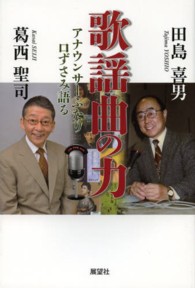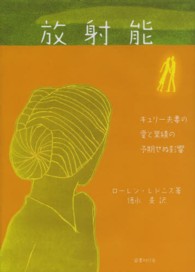- ホーム
- > 洋書
- > ドイツ書
- > Humanities, Arts & Music
- > History
- > antiquity
Description
(Text)
This monograph investigates the reception and image of the Archaic Greek lyric Poet Anakreon of Teos (ca. 570 - 486 BCE) in fifth-century Athens.
The focus is on the full-length marble portrait statue of Anakreon found in a Roman villa and now housed in the Ny Carlsberg Glyptotek in Copenhagen. The statue, widely believed to be a copy of a Greek bronze original that stood on the Athenian Akropolis some fifty years after the poet's death, raises a plethora of intriguing questions. What role did the Ionian poet, whose activity in Athens began under the Peisistratid tyrants, play in the
cultural and political program of the radical democratic statesman Perikles, or of the oligarchic opposition to Perikles? How were the distinctive features of the statue - its almost complete nudity and shaky stance hinting at inebriation - understood by the figure's contemporary viewers?
(Text)
This monograph investigates the reception and image of the Archaic Greek lyric Poet Anakreon of Teos (ca. 570-486 BCE) in fifth-century Athens.
The focus is on the full-length marble portrait statue of Anakreon found in a Roman villa and now housed in the Ny Carlsberg Glyptotek in Copenhagen. The statue, widely believed to be a copy of a Greek bronze original that stood on the Athenian Akropolis some fifty years after the poet's death, raises a plethora of intriguing questions. What role did the Ionian poet, whose activity in Athens began under the Peisistratid tyrants, play in the
cultural and political program of the radical democratic statesman Perikles, or of the oligarchic opposition to Perikles? How were the distinctive features of the statue its almost complete nudity and shaky stance hinting at inebriation understood by the figure's contemporary viewers?








